Original author: Vitalik Buterin, founder of Ethereum
Original translation: 0x js, Xiaozou, Golden Finance
An interesting contradiction in the crypto industry, which has become my digital home as a geo-nomad for the past decade, is its relationship to the topic of governance. The crypto industry grew out of the cypherpunk movement, which values independence from external constraints often imposed by ruthless and power-hungry politicians and corporations, and has long built technologies like torrent networks and encrypted messaging to achieve those ends.
However, with the emergence of new ideas like blockchains, cryptocurrencies, and DAOs, there is an important shift: these newer structures are long-lived and evolving, so they have an inherent need to establish their own governance, not just circumvent governance by unwelcome outsiders. The continued survival of these structures depends primarily on mathematical research, open source software, and other large public goods. This requires a shift in mindset: the ideology that maintains the crypto industry needs to transcend the ideology that created it.
This complex interplay between coordination and freedom, especially in the context of new technologies, is ubiquitous in our modern society, far beyond blockchain and cryptocurrencies. Earlier this year, Florida Governor Ron DeSantis signed a bill banning the production of synthetic (aka “lab-grown”) meat in his state, citing “global elites who want to control our behavior and push a diet of petri dish meat and bugs on Americans” and that we need to “prioritize our farmers and ranchers over… the World Economic Forum.” As you might expect, the Libertarian Party New Hampshire (LPNH) social account openly criticized the “authoritarian socialist” nature of the legislation. But it turns out that many other self-proclaimed libertarians don’t share this view:
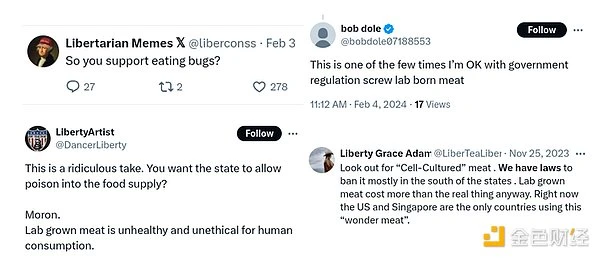
To me, LPNH’s criticism of DeSantis’ ban makes perfect sense: prohibiting people from eating a new, potentially more ethical and sustainable form of meat simply because of disgust is completely contrary to cherishing freedom. However, it’s clear that many people don’t see it that way. When I searched the internet for convincing arguments, the most convincing one I could find was this one by Roko Mijic: In short, once something like this is allowed, it will become mainstream, society will reorganize around it, and life will inevitably become increasingly difficult for those who don’t want to follow the crowd. This is true of digital cash, and even the Swedish central bank is worried about the accessibility of cash payments, so why doesn’t it happen in other areas of technology?
About two weeks after DeSantis signed the bill banning lab-grown meat, Google announced that it would be rolling out a feature in Android that will analyze phone calls in real time and automatically warn users if it thinks they might be being scammed. Financial scams are a big, growing problem, especially in regions like Southeast Asia, and they’re getting more sophisticated at a pace that’s harder for people to keep up with. AI is accelerating this trend. Here we see Google creating a solution to help warn users about scams, and what’s more, the solution is entirely client-side: no personal data is sent to any corporate or government Big Brother. It seems magical; it’s exactly the kind of technology I advocated for in my post introducing “d/acc.” Not all liberal-minded people are happy, however, and at least one critic, Signal Foundation president Meredith Whittaker, can hardly be dismissed as “just a Twitter troll.”
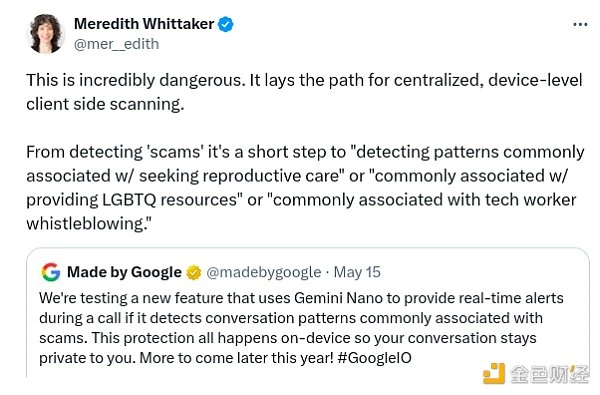
All three of these tensions are examples of a deep philosophical question that keeps me thinking: What should people like me who think of themselves as defenders of liberal principles actually be defending? Does an updated version of Scott Alexander’s idea that liberalism is a peace treaty make sense in the twenty-first century? Clearly, things have changed. Public goods are far more important and far larger than they once were. The internet has made communication abundant, not scarce. And as Henry Farrell analyzes in his book on weaponized interdependence, modern information technology not only empowers recipients but also enables creators to project power in a sustained way. Existing attempts to deal with these issues are often haphazard, trying to treat them as exceptions to a principle that need to be tempered by pragmatic compromise. But what if there were a principled way of looking at the world that valued freedom and democracy that could incorporate these challenges and treat them as the norm rather than the exception?
Introduction to the book Plurality
That’s not how Glen Weyl and Audrey Tang introduce their new book, Plurality: the future of collaborative technology and democracy. Glen’s account is slightly different, focusing on the increasingly antagonistic relationship between many in Silicon Valley’s tech world and the political center-left, and seeking a more collaborative way forward:
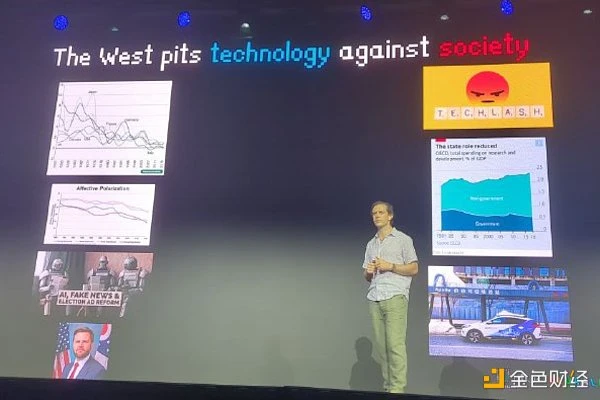
Glen Weyl introduces his book Pluralism during a lecture in Taipei
But for me, it was more in the spirit of the book to present an introduction to a range of related issues from my own perspective. After all, the explicit goal of Pluralism is to try to appeal to a wide range of people with a wide range of concerns, from all parts of the traditional political spectrum. I have long been concerned about what I see as a steady decline in support for democracy and even freedom, a decline that seems to have accelerated since about 2016.
I have also worked on governance issues first-hand in my role as a governance builder in the Ethereum ecosystem. At the beginning of my Ethereum journey, my original dream was to create a governance mechanism that was provably mathematically optimal, just like we have a provably optimal consensus algorithm. Five years later, my intellectual explorations eventually led me to theoretical arguments for why such a thing is mathematically impossible.
Glenn’s evolution of thought has been different from mine in many ways, but it has also had many similarities. His previous book, Radical Markets, laid out ideas inspired by classical liberal economics as well as the latest mathematical discoveries in the field, in an attempt to create better versions of property rights and democracy that address the biggest problems with both institutions. Like me, he has always found both liberal and democratic ideas compelling, and has tried to find an ideal combination of the two, treating them as opposing goals that need to be balanced rather than two sides of the same coin that need to be integrated. More recently, as in my case, the mathematical part of his social thought has also evolved in the direction of trying to treat not only individuals but also the connections between individuals as first-class objects that any new social design needs to consider and build around, rather than as errors that need to be eliminated.
It is in the spirit of these ideas and of the emerging shift from theory to practice that Glenn and Audrey’s book, Pluralism, is written.
How would I define pluralism in one sentence?
Glen Weyl defines pluralism most succinctly in his 2022 article “Why I Am A Pluralist”:
I understand pluralism as a social philosophy that recognizes and promotes prosperity and cooperation among different socio-cultural groups/systems.
If I had to expand on this a bit and define the book in four main points, I would say the following:
Glenns Hyperpolitics: The world today is caught in a narrow channel between conflict and centralization, and we need a new, upgraded, high-performance form of digital democracy to replace both.
Pluralistic atmosphere: The overarching themes are that (i) we should understand the world through a patchwork of models, rather than trying to extend any single model beyond its natural applicability; and (ii) we should take connections between individuals seriously and work to expand and strengthen healthy connections.
Pluralism-Inspired Mechanism Design: There is a set of principled mathematical techniques that allow for the design of social, political, and economic mechanisms that treat not only individuals as primary objects, but also the connections between individuals. Doing so can create newer forms of markets and democracies that address the problems common in todays markets and democracies, particularly in bridging tribal divides and polarization.
Audreys practical experience in Taiwan: During her tenure as Minister of Digital Affairs of Taiwan Province, China, Audrey has incorporated many diverse concepts, which is a starting point for learning and reference.
What is the super-politics of pluralism?
In Balaji Srinivasan’s magnum opus, Network Nation, Balaji describes his view of the world today as divided into three poles: the center-left English-speaking elite represented by the New York Times (NYT), communism, and the extreme individualist right represented by Bitcoin (BTC). Glenn gives his own description of “21st century political ideology” in his book Pluralism and elsewhere, as follows:
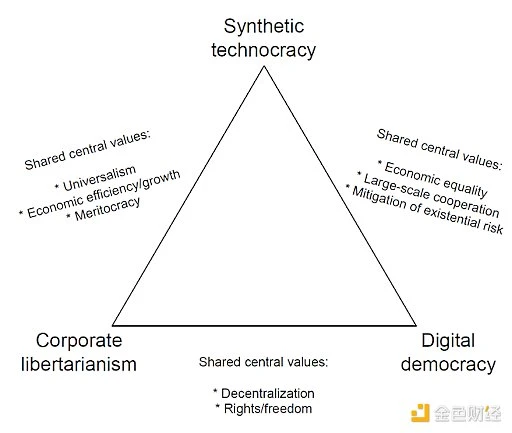
The names of these three are taken from Civilization VI, and in Pluralism, Glenn simplified their names to Technocracy, Liberalism, and Pluralism. He described these three as follows:
(Synthetic) Technocracy: Some mechanism run by AI and a small human elite creates lots of amazing things and ensures that everyone gets their share of what they need to live a good life (e.g. through UBI). The political opinions of non-elites are considered unimportant. Examples of this ideology include China, the World Economic Forum (You will have nothing, but you will be happy), the UBI advocated by Sam Altman and his friends, and from my recent travels, I might add the Museum of the Future in Dubai.
(Entrepreneurial) Libertarianism: maximal protection of property rights and freedom of contract, and the expectation that the most important projects will be started by some kind of great founder entrepreneur. Individuals are protected from abuse almost entirely by the right to opt out of any system that becomes too inefficient or exploitative. Examples of this ideology include books like The Sovereign Individual, free city movements like Prospera, and the Network Nation.
Digital democracy/pluralism: Using internet technology to create higher bandwidth democratic mechanisms that can aggregate preferences from a wide range of people and use these mechanisms to create a stronger and more effective third sector or civil society that can make better decisions. Glenn cites examples both from fiction, most notably Star Trek and anything by Ursula le Guin, and from real-life prototypes, most notably e-government in Estonia and Taiwan.
Glenn sees pluralism as a way to avoid three failure modes simultaneously: coordination failure leading to conflict (which he sees as a risk with liberalism), centralization and authoritarianism (which he sees as a risk with technocracy), and stagnation (which he sees as a risk with “old world democracies” that lose competitiveness to liberalism and technocracy). Glenn sees pluralism as an underexplored alternative, and his project will flesh out that idea, while Audrey’s will be realized first in Taiwan and then elsewhere.
If I were to summarize the difference between Balaji’s plan and Glenn and Audrey’s, I would summarize it as follows. Balaji’s vision revolves around creating new alternative institutions and new communities around these new institutions, and creating safe spaces where they have a chance to grow. Glenn and Audrey’s approach, on the other hand, is best captured in the “fork and merge” strategy of Taiwan’s e-government:
So when you go to a regular government website, and change the O to a 0, this domain hack ensures that youre looking at a shadow government version of the same website, except its on GitHub, except its powered by open data, except theres real interaction, and you can actually discuss any budget item around this visualization with your fellow citizen hackers.
Many of the projects in Gov Zero became so popular that the government and ministries ended up merging their code, so if you go to an official government website it looks exactly like the Citizen Hacker version.
In Audreys vision, there is still some opt-in and opt-out, but there is a tighter feedback loop through which improvements from micro-opt-outs are integrated back into the mainline social infrastructure. Balaji would ask: How do we let the synthetic meat people have their synthetic meat cities, and the traditional meat people have their traditional cities? Glenn and Audrey might ask: How do we structure the top layer of society to guarantee that people are free to do either one, while still retaining the benefits of being part of the same society and collaborating in every other way?
What is the pluralistic model of “the world as it really is”?
The pluralist view of how to improve the world begins with a view of how to describe the world as it is. This is a key part of Glenn’s evolution, as Glenn’s views on these issues a decade ago were much more inspired by economics. It is therefore instructive to compare and contrast the pluralist worldview with that of traditional economics.
Traditional economics focuses on a small number of economic models that make specific assumptions about how entities operate and treats deviations from these models as flaws whose consequences are not too serious in practice. As given in textbooks, these assumptions include:
Competition: The common case for market efficiency relies on the assumption that no single market participant is large enough to significantly influence market prices through its behavior—instead, the prices they set determine only whether anyone buys their products.
Perfect Information: People in the market fully understand the products they are buying
Perfectly rational: people in the market have common goals and are committed to achieving those goals (which can be altruistic)
No externalities: The production and use of items traded on the market only affects producers and users, and does not affect third parties unrelated to you
In my own recent writing, I’ve generally emphasized an assumption related to competition but more powerful: independent choice. Many mechanisms proposed by economists work perfectly well if you assume that people act independently to pursue their own independent goals, but they quickly break down as soon as the participants coordinate their actions through some mechanism other than the rules you set. Second price auctions are a good example: they are provably perfectly efficient if the above conditions are met and the participants are independent, but they break down badly if the highest bidders can collude. Quadratic funding, invented by me, Glen Weyl, and Zoe Hitzig, is similar: it’s a provably ideal mechanism for funding public goods if the participants are independent, but if even two participants collude they can extract unlimited funds from the mechanism. My own work on pairwise-bounded quadratic funding attempts to fill this hole.
But once you start analyzing extremely important parts of society that don’t look like trading platforms, the usefulness of economics declines further. Take conversation, for example. What are the motivations of the speaker and the listener in a conversation? As Hansen and Simler point out in The Elephant in the Brain, if we try to model conversation as an exchange of information, then we see people closely guarding information and trying to play tit-for-tat games, talking only to get responses from others. In reality, however, people are generally eager to share information, and criticisms of people’s conversational behavior often focus on the tendency of many people to talk too much and listen too little. In public conversations such as on social media, a major topic of analysis is what kinds of statements, claims, or memes go viral—a term that directly acknowledges that the most natural scientific field of analogy is not economics but biology.
So what is Glenn and Audreys alternative? A big part of it is simply recognizing that there is simply no single model or scientific method that perfectly explains the world, and that we should use a combination of different models, recognizing the limitations of each models applicability. In one key section, they write:
Mathematics in the 19th century saw the rise of formalism: the pursuit of a precise and rigorous treatment of the definitions and properties of mathematical structures in order to avoid inconsistencies and errors. In the early 20th century, there was a desire to “solve” mathematics, perhaps even to give an exact algorithm for determining the truth or falsity of any mathematical claim. [6] On the other hand, 20th century mathematics was characterized by a surge in complexity and uncertainty.
Gödels Theorem: Several early 20th century mathematical results, most notably Gödels Theorem, showed that key parts of mathematics cannot be completely solved in some fundamental and irreducible way.
Computational complexity: Even if reductionism were possible in principle/theoretically, the amount of computation required to predict higher-level phenomena from their component parts (its computational complexity) would be so large that performing it would be unlikely to be of practical significance.
Sensitivity, Chaos, and Irreducible Uncertainty: Many even relatively simple systems exhibit chaotic behavior. A system is chaotic if small changes in initial conditions over a long period of time lead to radical changes in its final behavior.
Fractals: Many mathematical structures have been shown to have similar patterns at different scales. The Mandelbrot set is a good example.
Glen and Audrey go on to give similar examples from physics. As one of the many co-contributors to this book, I contributed an example that was accepted:
The three-body problem, best known for its role in Liu Cixins science fiction series, shows that even under simple Newtonian physics, the interactions between three bodies are so chaotic that their future behavior cannot be predicted using simple math. Yet we can still regularly use 17th-century abstractions like temperature and pressure to solve the trillion-body problem, and these abstractions are useful enough for everyday applications.
In biology, a key example is:
Similarities between organisms and ecosystems: We find that many different organisms (“ecosystems”) can exhibit features similar to multicellular life (homeostasis, susceptibility to disruption or overgrowth of internal components, etc.), reflecting their emergence and multi-scale organization.
By now, the theme of these examples should be easy to understand. No one model works across the globe, and the best we can do is piece together multiple models that work well in a variety of contexts. The underlying mechanisms are not the same at different scales, but they do “rhyme.” Social science, they argue, needs to move in the same direction. This, they argue, is where “technocracy” and “liberalism” fail:
In the technocratic vision we discussed in the last chapter, the “chaos” of the existing administrative system will be replaced by a large-scale, unified, rational, scientific, AI-based planning system. This unified subject transcends localism and social diversity and is considered to be able to give “just” answers to any economic and social problem, transcending social divisions and differences. Therefore, it seeks not to cultivate and exploit social diversity and heterogeneity, but to cover them up at best and erase them at worst, which social science believes determine people’s interests, participation, and values.
In the liberal vision, the sovereignty of the atomic individual (or in some versions, a homogeneous and closely aligned group of individuals) is the core aspiration. Social relations are best understood in terms of “clients,” “exits,” and other capitalist dynamics. Democracy and other means of coping with diversity are seen as failure modes of a system that cannot achieve full coordination and freedom.
One particular model that Glenn and Audrey return to repeatedly is Georg Simmel’s theory of personality, which posits that personality emerges from each individual’s unique intersection of different groups. They describe this as a third option to “atomistic individualism” and collectivism. They write:
According to [Georg Simmel], humans are highly social creatures, and therefore their identities are formed through social relationships. Humans gain key aspects of their sense of self, purpose, and meaning through participation in social, linguistic, and cohesive groups. In simple societies (e.g., isolated, rural, or tribal), people spend most of their lives interacting with the kin group we described above. This circle (primarily) collectively defines their identity, which is why most scholars who study simple societies (e.g., anthropologist Marshall Sahlins) tend to favor methodological collectivism. [14] However, as we noted above, as societies become urbanized, social relationships become more diverse. People work in one circle, worship in another, support political causes in a third, entertain in a fourth, cheer for sports teams in a fifth, perceive themselves as discriminated against in a sixth, and so on.
When this happens, the sense of self that people have in common with those around them at any given time gradually diminishes; they begin to feel both “unique” (viewed in a positive light) and “isolated/misunderstood” (viewed in a negative light). This creates a sense of what he calls “personalization,” which helps explain why social scientists (like economists) who focus on complex urban environments tend to espouse methodological individualism. Ironically, however, as Simmel points out, this “individualization” is precisely because the “individual” is split among many loyalties and thus divided.
This is the core idea repeatedly reiterated in the book Pluralism: to regard the connections between individuals as the primary object in mechanism design, rather than focusing solely on the individuals themselves.
How does pluralism differ from liberalism?
In his 1974 book, Anarchy, State, and Utopia, Robert Nozick argued for a minimal government that performed basic functions, such as preventing people from committing violent acts, but left other functions up to people to organize themselves into communities consistent with their values. Since then, the book has become a manifesto for many classical liberals describing their ideal world.
Two examples that come to mind are Robin Hanson’s recent article “Liberalism as Deep Multiculturalism” and Scott Alexander’s 2014 article “Archipelagoes and Atomic Communitarianism.” Robin is interested in this concept because he wants to see a world with more of what he calls deep multiculturalism:
Superficial multiculturalism tolerates and even celebrates cultural markers such as clothing, food, music, myths, art, furniture, accents, festivals, and gods. But it is also usually much less tolerant of cultural values such as war, sex, race, childbearing, marriage, work, children, nature, death, medicine, schools, etc. It seeks a mutual understanding that we are all (or should be) actually the same once we look beyond the markers of difference.
In contrast, deep multiculturalism accepts and even celebrates the coexistence of multiple cultures with very different values. It seeks to make the world, and even geographical regions, tolerant of these different cultures in an environment of peace and prosperity. It expects some distrust, conflict, and even hostility between cultures due to differences in values. But it sees this as the price of deep cultural diversity.
Since the primary purpose of most non-liberal government activity is to create and maintain a shared community/culture and its values, this impulse to use government to promote a shared culture seems to be a major obstacle to liberal governance. That is, liberals want shared government without shared community or culture. The usual liberal vs. statist political axis might be seen as an axis about the extent to which we want to share culture, versus allowing for different cultures.
Scott Alexander came to a similar conclusion in his 2014 article, though his basic goal was slightly different: he wanted to find an ideal political architecture that would create opportunities for organizations to support the public good and limit culturally subjective public bad behavior, while limiting the pervasive tendency for subjective arguments about higher-order harms (“homosexuality is corroding the fabric of society”) to become masks for oppression. Balaji’s Network State is a more specific proposal for a social architecture that attempts to achieve exactly the same goals.
So a key question worth asking is: in what ways is liberalism inadequate for achieving a pluralistic society? If I had to sum up the answer in two sentences, I would say:
Pluralism means not only achieving diversity but also leveraging diversity and working more actively to build higher-level institutions that maximize positive-sum interactions among different groups and minimize conflict.
Pluralism exists not only at the societal level, but also within each individual, allowing each individual to be part of multiple tribes at the same time.
To understand (2), we can zoom in on a specific example. Let’s look at the debate surrounding Google’s on-device anti-fraud scanning system in the opening section. On the one hand, a tech company released a product that seemed to be motivated by a sincere desire to protect users from financial fraud (a very real problem; I know people who have lost hundreds of thousands of dollars to it), and it even went a step further and checked the most important “cypherpunk values” box: data and computation remain entirely on the device, and it’s purely for warning you, not reporting you to law enforcement. On the other hand, we have Meredith Whittaker, who sees the product as a slippery slope to something even more oppressive.
Now, let’s look at Glen’s preferred alternative: a Taiwanese app called Message Checker. Message Checker is an app that runs on your phone that intercepts incoming message notifications and analyzes them. It includes features that have nothing to do with scams, such as using client-side algorithms to identify the messages that are most important to you. But it can detect scams, too:

A key part of the design is that the app doesn’t force all users to follow a uniform set of rules. Instead, it lets users choose which filters to turn on or off:

From top to bottom: URL check, cryptocurrency address check, rumor check.
These are all filters made by the same company. A more ideal setup would be to have it as part of the operating system and have an open marketplace where you could install different filters created by a variety of different commercial and non-profit players.
The key multivariate feature of this design is that it gives users more granular opt-out freedom, avoiding an all-or-nothing approach. If a norm could be established that device anti-scam scanning must work this way, it would seem to make Meredith’s dystopia less likely: if an operator decided to add a filter that deemed information about transgender care (or, if your fears run in the other direction, advocating for limiting gender self-classification in athletics) as dangerous content, individuals could simply not install that particular filter, and they would still benefit from the rest of the anti-scam protections.
An important implication is that “meta-institutions” need to be designed to encourage other institutions to respect this ideal of fine-grained freedom of exit — after all, as we have seen with software vendor lock-in, organizations do not automatically adhere to this principle!
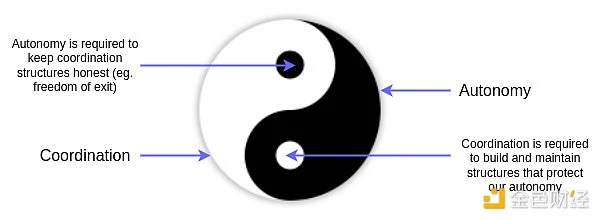
One way to think about the complex interplay between coordination and autonomy in pluralism.
How is pluralism different from democracy?
Once you read the chapter on voting, many of the differences between pluralistic and traditional democracy become clear. Pluralistic voting mechanisms have some powerful, explicit answers to the problem of democracy is two wolves and a sheep voting on what to eat and the related worry about democracy degenerating into populism. These solutions build on Glenns earlier ideas about quadratic voting, but go a step further by explicitly counting votes at a higher rate if those votes come from actors who are more independent of each other. Ill cover this in more detail in a later section.
Aside from the major theoretical leap from counting just individuals to counting connections, there are broad thematic differences between the two. One key difference is the relationship between pluralism and the nation-state. Liberal philosopher Chris Freiman summed up one of the main shortcomings of nation-state democracy very well in this tweet, which was personally very inspiring to me:
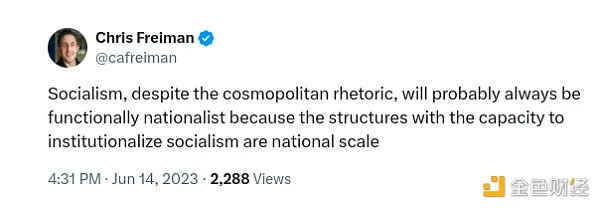
This is a serious gap: two-thirds of global inequality occurs between countries, not within them; a growing number of public goods (especially digital ones) are neither global nor explicitly tied to any particular nation-state; and the tools we use to communicate are highly international. The democratic project for the 21st century should take these basic facts much more seriously.
Pluralism is not inherently opposed to the existence of nation-states, but it explicitly strives to move beyond reliance on the nation-state as the locus of action. It provides guidance for a variety of actors, including transnational organizations, social media platforms, other types of businesses, artists, and more. It also explicitly recognizes that for many people, no single nation-state can dominate their lives.
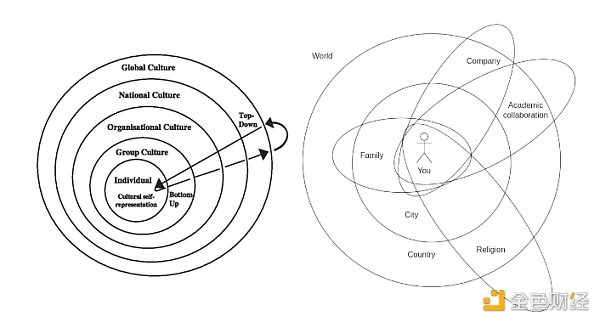
Left: The concentric circle view of society, from a sociology paper in 2004. Right: The pluralistic view of society: intersecting but non-hierarchical circles.
Ken Suzuki’s Smooth Society and its Enemies develops an important theme of pluralism in more detail: membership in an organization should not be seen as a matter of “right or wrong.” Instead, there should be different degrees of membership, and those different degrees of membership will bring different benefits and different degrees of obligations. This is an aspect of society that has always been true, but has become even more important in an internet-first world, where our communities are no longer necessarily nested and completely overlapping.
What specific technologies does the pluralist vision advocate?
The book Pluralism advocates for a fairly broad set of digital and social technologies that span what are traditionally thought of as a large number of “spaces” or industries. I’ll focus on a few examples in specific categories.
identity
First, Glenn and Audrey offer a critique of existing approaches to identity. Some key quotes on the subject:
Many of the simplest ways to establish identity simultaneously undermine it, especially online. Passwords are often used to establish identity, but unless this authentication is done very carefully, passwords can be compromised more widely, rendering them useless for future authentications because attackers will be able to impersonate them. Privacy is often considered a nice-to-have, especially useful for those who have something to hide. But in identity systems, protecting private information is core to their usefulness. Any useful identity system must be judged by its ability to both establish and protect identity.
About biometrics:
[Biometrics] have significant limitations in determining and protecting identity. Tying such a wide range of interactions to a single identifier tied to a set of biometric information collected from a single individual at the time of enrollment (or registration) forces a stark trade-off. On the one hand, if (as with Aadhaar) the administrators of the program use biometrics for authentication over time, they would be able to tie or see activity to that of the person to whom the identifier points, thereby gaining an unprecedented ability to monitor a wide range of citizen activity and potentially undermine or target the identities of vulnerable groups.
On the other hand, if only biometrics are used to initialize accounts, as Worldcoin does, the system can be easily stolen or sold, a problem that has seriously affected the operation of related services... If at some point in the future, the eye can be deceived by an AI system combined with advanced printing technology, then such a system may have an extreme single point failure.
Glen and Audrey prefer to take an intersectional social identity approach to this: using the full range of a person’s behaviors and interactions to achieve the underlying goals of identity systems, such as determining the degree of community membership and a person’s trustworthiness:
This socialized, pluralistic approach to online identity was pioneered more than 20 years ago by Danah Boyd in her visionary master’s thesis on “multifaceted identity.” [28] While she focused primarily on the benefits of such a system for individuals’ sense of agency (in the spirit of Simmel), its potential benefits for the balance between identity construction and protection are more surprising:
Comprehensiveness and redundancy: For almost anything we might want to prove to a stranger, there are people and institutions (usually many people) who can vouch for that information, without any specialized surveillance strategy. For example, someone who wants to prove they are over a certain age can turn to friends who have known them for a long time, the school they attended, doctors who have verified their age at various times, and of course the government who has verified their age.
Privacy: Perhaps more interestingly, the “publishers” of all of these properties know this information from interactions that most people would consider consistent with “privacy”: we don’t worry about the common knowledge of these social facts as much as we worry about corporate or government surveillance.
Security: Pluralism also avoids many of the “single point of failure” problems. Even the corruption of a few individuals and institutions will only affect those who depend on them, which may be a very small part of society, and even for them, the redundancy mentioned above means that they may only suffer a partial reduction in the verification capacity they can achieve.
Resilience: An individual can rely on a set of relationships, such as 3 out of 5 friends or an institution, to recover their keys. This “social recovery” has become the gold standard for many Web3 communities, and is even increasingly being adopted by major platforms like Apple.
The core message is that any single-factor technology is too fragile, so we should use multi-factor technology. For account recovery, it is relatively easy to understand how it works, and the security model is easy to understand: each user chooses what they trust, and if a user makes a wrong choice, the consequences are mostly limited to that user. However, other use cases for identity are more challenging. For example, UBI and voting seem to inherently require global (or at least community-wide) agreement on who the members of the community are. However, there are efforts to bridge this gap and create something that comes close to feeling like a single global thing, while being based on subjective multi-factor trust.
The best example in the Ethereum ecosystem is Circles, a UBI token project based on a trust network where anyone can create an account (or an unlimited number of accounts) and generate 1 CRC per hour, but you will only consider the coins of a given account as real Circles if that account is connected to you through the trust network graph.
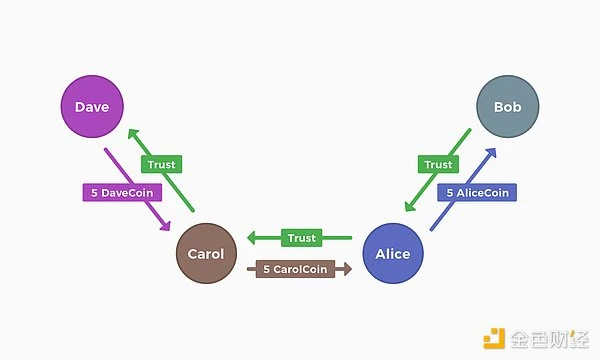
Trust propagation in Circles, excerpted from the Circles whitepaper
Another approach is to abandon the abstract concept of you are either a human or you are not a human entirely, and try to use multiple factors to determine the trustworthiness and membership of a given account, and give it UBI or voting rights proportional to that score. Many of the airdrops currently underway in the Ethereum ecosystem, such as the Starknet airdrop, follow this principle.
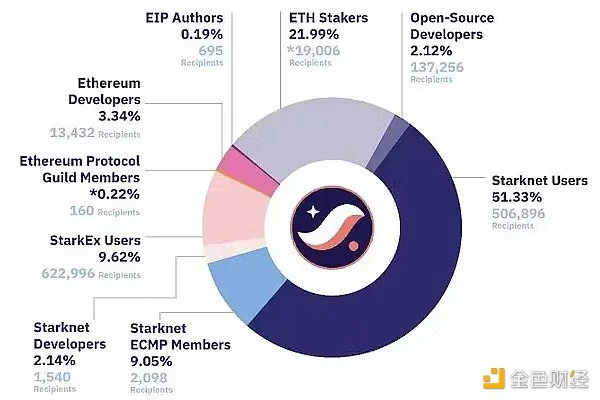
Starknet airdrop recipient categories. Many recipients ended up falling into multiple categories.
Multiple currencies and assets
In Radical Markets, Glenn focused on “stable and predictable, but intentionally imperfect” versions of property rights, such as Harberger taxes. He also focused on “market-like” structures that can fund public goods rather than just private goods, most notably quadratic voting and quadratic financing. Both ideas remain prominent in Pluralism. A non-monetary implementation of quadratic financing is called Plural Credits, which are used to help record contributions to the ledger itself. There has been some updates on the ideas around Harberger taxes, which seek to extend the idea to mechanisms that allow assets to be partially owned by multiple different individuals or groups at the same time.
In addition to the continued emphasis on hyperscale market design, one of the new additions to the plan is a greater emphasis on community currencies:
In a polycentric structure, various communities would have their own currencies that could be used in limited areas, rather than as a single universal currency. Examples would be housing or school vouchers, rides at the fair, or credits for buying food from various stands at a university. [18] These currencies might be partially interoperable. For example, two universities in the same town might allow their food vouchers to be exchanged for one another. But it would be against the rules, or even technically impossible, for a holder to sell a community currency for a broader currency without the communitys consent.
The underlying goal is to combine local mechanisms that are intentionally kept local with global mechanisms that enable large-scale cooperation. Glenn and Audrey believe that their modified versions of markets and property are the best candidates for the largest-scale global cooperation:
Those who pursue pluralism should not wish for markets to disappear. Something must exist to mediate coexistence across the broadest social distance, even if it is not cooperation, and many other ways of achieving this, even as trivial as voting, run a greater risk of homogenization because they involve deeper connections. Socially conscious global markets offer greater promise for pluralism than global government. Markets must develop and thrive alongside many other modes of cooperation to ensure a pluralistic future.
vote
In Radical Markets, Glenn advocates quadratic voting, which deals with the problem of allowing voters to express preferences of varying strengths while avoiding the failure mode where the most extreme or best-resourced voices dominate decision making. In Pluralism, the core problem that Glenn and Audrey are trying to solve is different, and the following section nicely summarizes the new problem they are trying to solve:
Giving twice as many votes to a party with twice as much legitimate interest in a decision is natural, but misleading. The reason is that this will usually give them more than twice as much power. On average, uncoordinated voters cancel each other out, so the combined influence of 10,000 completely independent voters is much less than the influence of one person with 10,000 votes.
When the background signals are completely uncorrelated and numerous, there is a simple mathematical way to explain this: a series of uncorrelated signals grows at the square root of their number, while a correlated signal grows linearly in proportion to its strength. So 10,000 uncorrelated votes have the same weight as 100 correlated votes.
To solve this problem, Glenn and Audrey advocated designing a voting mechanism using the decreasing proportionality principle: adding irrelevant signals together, but only giving sqrt(N) votes to N relevant signals.
This approach has precedent in countries such as the United States and in international organizations, which typically have some councils that give subunits (states in the former case, countries in the latter) a number of votes proportional to their population or economic strength, and other councils that give each subunit one vote, regardless of its size. In theory, 10 million voters in a large state are more important than 1 million voters in a small state, but the signal they represent is more relevant than 10 million voters from ten different states, so the votes of 10 million voters in a large state should be somewhere in between these two extremes.
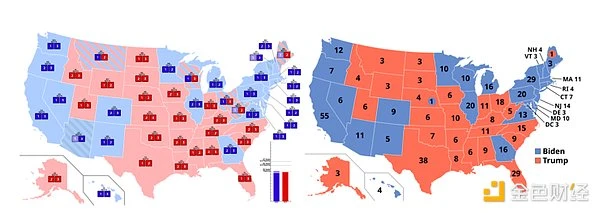
Left: The U.S. Senate, where every state, regardless of size, has two senators. Right: The U.S. Electoral College, where the number of senators is roughly proportional to population.
Of course, the key challenge for making this design work more generally is to determine who is “irrelevant”. Actors acting in concert pretending to be inconsistent in order to increase their legitimacy (aka “disinformation campaigns”, “decentralized reality shows”, “puppet states”…) is already a mainstream political strategy and has been around for centuries. If we instantiate a mechanism for determining who is relevant to whom by analyzing Twitter posts, people will start to craft their Twitter content to appear as irrelevant as possible to the algorithm, and may even deliberately create and use bots to do this.
Here I can present my own proposed solution to this problem: vote on multiple issues simultaneously, and use the votes themselves as a signal of who is relevant to whom. One implementation of this is pairwise quadratic financing, which assigns a fixed budget to each pair of participants, which is then divided up based on the intersection of how the pairs voted. You can do something similar with voting: instead of giving each voter one vote, give each pair of voters one (divisible) vote:
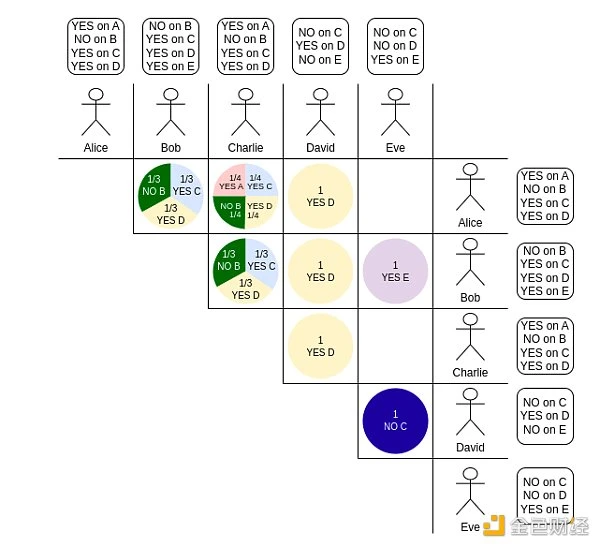
If you go by the raw numbers, the yes vote wins 3-2 on question C. But Alice, Bob, and Charlie are highly correlated voters: they agree on almost everything. Meanwhile, David and Eve only agree on C. In pairwise voting, all the “against C” votes in the (David, Eve) pair will be assigned to C, which is enough to overwhelm the “for C” votes of Alice, Bob, and Charlie, whose pairwise votes for C add up to only 11/12.
The key trick to this design is that determining who is “relevant” and “irrelevant” is an inherent part of the mechanism. The more two actors agree on one issue, the less they vote on all other issues. A group of 100 “organically” diverse actors will receive fairly high voting weights because the overlap area between any two actors is relatively small. At the same time, a group of 100 people who have similar beliefs and listen to the same media will receive lower weights because their overlap area is large. A group of 100 accounts all controlled by the same owner will have perfect overlap because that is the strategy to maximize the owner’s goal, but they will receive the lowest weights.
This pairwise approach is not mathematically ideal for implementing this sort of thing: in the case of quadratic funding, the amount of funds an attacker can extract grows as the square of the number of accounts they control, whereas it should ideally be linear. It is an open research question how to specify an ideal mechanism, whether quadratic funding or voting, that has the most robust properties against attackers who control multiple accounts or correlated voters.
This is a new kind of democracy that naturally corrects what is sometimes labeled “NPC” in internet discourse: a large group of people who may be just one person because they all consume exactly the same information sources and believe exactly the same things.
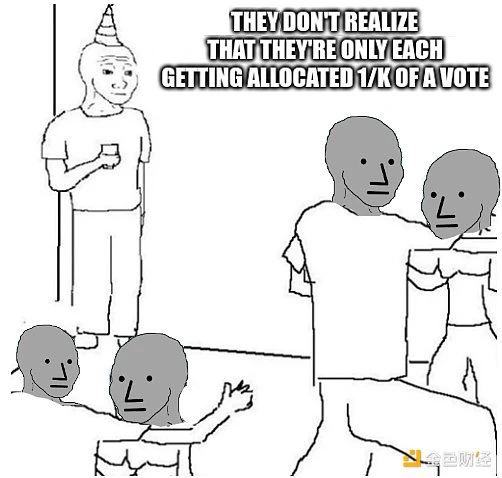
dialogue
As I’ve said many times, especially in the context of DAOs, the success or failure of governance is about 20% based on the formal governance mechanisms and about 80% based on the communication structures that participants have before they finalize their opinions and input them into governance. To that end, Glen and Audrey also spend a lot of time thinking about better technology for large-scale conversations.
One conversation tool they focused on was Polis. Polis is a system that allows people to submit statements about an issue and vote on each other’s statements. At the end of a round, it identifies the different main “clusters” of different opinions and lists the statements that have the most support from all clusters.

Source: https://words.democracy.earth/hacking-ideology-pol-is-and-vtaiwan-570d36442ee5
In fact, Polis has been used in public discussions of some legal proposals in Taiwan, including one to create rules for Uber-like ride-hailing services. Polis has also been used in other contexts around the world, including some experiments within the Ethereum community.
The second tool they focused on had more success in becoming mainstream, but in large part due to the unfair advantage of being introduced to an existing social media platform with hundreds of millions of users: Twitter’s Community Notes.
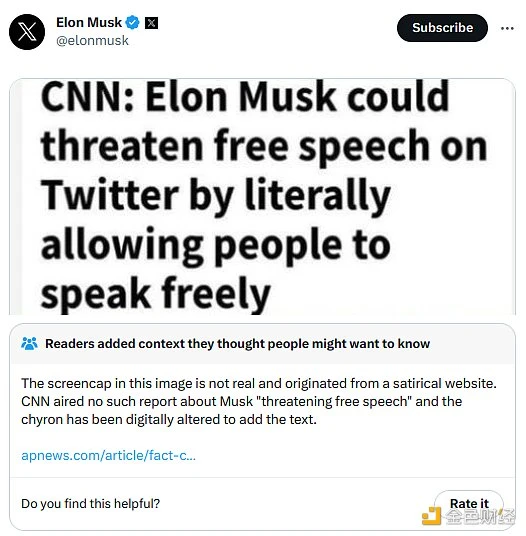
Community Notes also uses an algorithm that allows anyone to submit proposed annotations for a post and displays the annotations that are highest rated by people who disagree with most of the other annotations. I described this algorithm in more detail in my review of the platform. Since then, Youtube has announced that they plan to launch a similar feature.
Glen and Audrey hope that the ideas behind these mechanics can be expanded and applied more broadly across the platform:
While [Community Notes] currently ranks all opinions across the platform in a single range, we can imagine mapping out a range of communities within the platform and leveraging its bridge-based approach to prioritize not only notes but also content to get attention in the first place.
The ultimate goal is to try to create large-scale discussion platforms that are not designed to maximize metrics such as engagement, but are intentionally optimized for consensus points between different groups. Mutual benefit, but also to identify and exploit every possible opportunity for collaboration.
Brain-to-brain communication and virtual reality
Glenn and Audrey devote two entire chapters to “post-symbolic communication” and “immersive shared reality.” The goal here is to spread information between people at a much higher bandwidth than markets or conversations can achieve.
Glenn and Audrey describe an exhibition in Tokyo that allows visitors to realistically experience what it’s like to grow older:
Visors blur vision, simulating cataracts. Voices are stripped of their high notes. Facial expressions blur in a photo booth reflecting the test of old age’s perception. In a bustling market, the simple act of recalling a memorized shopping list becomes an adventure. Marking in place with weights on ankles and leaning on shopping carts simulates the wear and tear of time on the body or the weight of age on posture.
They argue that in the future, using technologies such as brain-computer interfaces, more valuable and realistic experiences like these could be achieved. “Immersive shared reality” encompasses what we usually call “virtual reality” or “metaverse”, but is broader than that and is described as a design space between post-symbolic communication and conversation.
Another book I read recently on a similar topic is Virtual Society: The Metaverse and the New Frontier of Human Experience by Herman Narula. Herman focuses on the social value of virtual worlds and how they can support coordination within society if given the right social meaning. He also focuses on the risks of centralized control and argues that the ideal metaverse should be created by organizations that are more like non-profit DAOs than traditional companies. Glen and Audrey have very similar concerns:
Corporate control, surveillance, and monopoly: ISR blurs the lines between public and private, with digital spaces that can be both private and open to broad audiences or observed by corporate service providers. Unless ISR networks are built according to the principles of rights and interoperability we highlighted above, and governed by the broader pluralistic governance approaches to which much of the rest of this book is devoted, they will become the most ironclad monopoly cages we know of.
If I were to point to one difference in their visions, it would be this. Virtual Society focuses more on the shared storytelling and long-term continuity aspects of virtual worlds, pointing out how games like Minecraft have won the hearts and minds of hundreds of millions of people despite being very limited from a cinematic immersion perspective by modern standards. Pluralism, on the other hand, seems to focus more (but far from exclusively) on sensory immersion, and is more open to short experiences. Sensory immersion, the argument goes, is uniquely powerful in conveying certain kinds of information that are otherwise difficult for us to access. Time will tell which of these visions, or which combination of the two, will succeed.
Where does pluralism fit into the contemporary ideological landscape?
As I reflect on the political changes we’ve seen since the early 2010s, one thing that strikes me is that the movements that have been successful in the current environment all seem to have one thing in common: they are object-level, rather than meta-level. That is, rather than seeking to promote broad, overarching principles about how to solve social or political problems, they seek to promote specific positions on specific issues. Some examples that come to mind include:
YIMBY: Standing for Yes, In My Back Yard, the YIMBY movement aims to fight highly restrictive zoning regulations (such as in the San Francisco Bay Area) and expand the freedom to build housing. If successful, they believe it will reduce the largest single component of the cost of living for many people and increase GDP by up to 36%. YIMBY has had many political victories recently, including a major zoning liberalization bill in California.
Crypto Industry: Ideologically, the industry stands for the principles of freedom, decentralization, openness, and anti-censorship. In practice, much of the crypto industry ends up being more focused on the openness of the global financial system and the freedom to hold and spend money.
Life extension: The concept of using biomedical research to figure out how to intervene in the aging process before it progresses to the point of disease, potentially giving us longer (and perfectly healthy) lifespans, has become mainstream over the past decade.
Effective Altruism: Historically, the effective altruism movement represented the broad application of a formula: (i) caring about doing the most good, and (ii) rigorously identifying which charities actually achieve that goal, noting that some charities are thousands of times more effective than others. Recently, however, the most prominent part of the movement has shifted to focusing on the single issue of AI safety.
Of those modern movements that are not issue-driven in this way, a large portion can be seen as vague cults of personality, united around whatever set of positions are taken and changed in real time by a single leader or a small, well-coordinated elite. Others can be criticized as ineffective and inconsistent, constantly trying to force an ever-changing list of causes under the umbrella of an ill-defined, unprincipled “Omnicause.”
If I had to ask myself why these shifts occur, I would say this: large groups have to coordinate around something. And the reality is that you either coordinate around (i) principles, (ii) a mission, or (iii) a leader. When the existing set of principles becomes perceived as outdated and ineffective, the other two alternatives naturally become more popular.
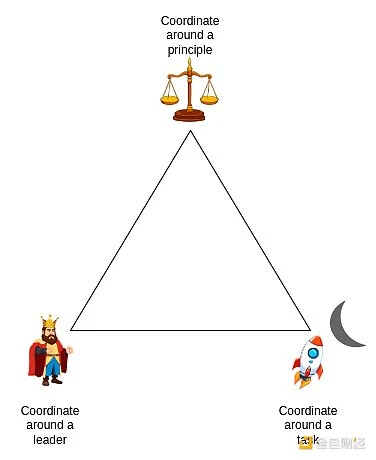
Coordinating around a task is effective, but it is temporary, and any social capital you have accumulated will easily dissipate once that specific task is accomplished. Leaders and principles are effective because they are task factories: they can continuously output new things to do and new answers to new problems. Of the two options, principles are more socially scalable and more durable.
Pluralism seems to run in stark contrast to the broader trend. Along with very few other modern movements (perhaps the Network State), pluralism’s scope extends far beyond any single mission, and it seeks to coordinate around principles rather than leaders. One way to understand pluralism is that it recognizes that (at least on a very large scale) coordinating around principles is the superior point of the triangle, and it is trying to figure out a new set of principles that are applicable in the 21st century. Radical markets sought to reshape the field of economics and mechanism design. Pluralism seeks to reshape liberalism.
This diagram by Gisele Chou does a great job of illustrating how all of the mechanisms described in the sections above fit together into a framework:
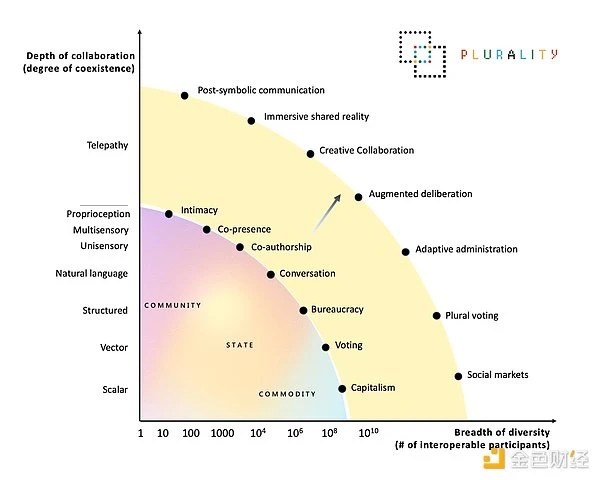
In some ways, this framework makes perfect sense. Philosopher Nassim Taleb likes to quote Geoff and Vince Graham to describe his rejection of “scale-independent universalism”: “At the federal level, I’m a liberal; at the state level, I’m a Republican; at the local level, I’m a Democrat; and among my family and friends, I’m a socialist.” Pluralistic philosophy takes this very seriously, suggesting different mechanisms for different scales.
On another level, it sometimes feels like “pluralistic atmosphere” is an umbrella that brings together very different concepts that have very different reasons for accepting or rejecting them. For example, “it’s important to have healthy connections between people” is a very different statement from “voting mechanisms need to account for differences in connectedness.” It’s entirely possible to use pairwise quadratic funding to build a new and better United Nations to finance cooperation and world peace, but at the same time, “creative collaboration” is overrated and great works should be the vision of one author. Part of this seeming inconsistency is due to the book’s diverse authorship: for example, in addition to Glenn and Audrey, the VR and brain-to-brain communication sections were written by Pooja Olhav. But this is the weakness of all philosophy: 19th-century liberalism combined democracy and markets, but it was the composite work of many people with different beliefs. To this day, there are many people who like democracy and are skeptical of markets, or like markets and are skeptical of democracy.
So a question worth asking is: if your background intuitions about various issues differ in some ways from the “pluralist atmosphere,” can you still benefit from pluralist thought? I think the answer is yes.
Is pluralism compatible with a wild exponential future?
Reading Pluralism, you might get the impression that while Glen and Audrey’s meta-level vision of conversation and governance is very appealing, they don’t really see anything too radically technological happening in the future. Here are the specific target outcomes they hope to achieve:
We believe it can increase economic output in the workplace by 10% and boost growth by one percentage point.
In the health field, we believe it can extend human life by 20 years.
In the media sector, it can bridge the divides created by social media, provide sustainable funding, expand participation, and significantly increase press freedom.
For the environmental sector, it is central to solving most of the serious environmental problems we face, perhaps even more important than traditional green technologies.
In education, it could upend the current linear structure of schooling, enabling more diverse and flexible pathways to lifelong learning.
These are all very good results, and ambitious goals for the next decade. But the goals I want to see from a technologically advanced society are much bigger and more far-reaching than these. When I read this section, I was reminded of my recent descriptions of the Future Museums in Dubai and Tokyo:
However, the solutions they propose are mostly tweaks that try to make the world a little gentler and friendlier for people with these conditions: robots that can provide guidance to people, write Braille on business cards, and so on. These are all very valuable things that can improve the lives of many people. But they are not what I expect to see in the Museum of the Future in 2024. I want to see solutions that allow people to truly see and hear again, such as optic nerve regeneration and brain-computer interfaces.
Dubais attitude towards these issues touches my soul deeply, while Tokyos does not. I dont want a future that is 1.2 times better than the present, with 84 years of comfort instead of 70. I want a future that is 10,000 times better than the present... If I become weak due to illness, living in an environment that allows me to be comfortable despite the illness is certainly an improvement. But what I really want is technology that can repair me and make me strong again.
Dubai is an interesting example because it also uses another technique that touches my soul deeply: geoengineering. Today, the use and risks of geoengineering are fairly local: the UAE practices cloud seeding, and some people blame Dubai’s recent flooding on it, despite a consensus among experts to the contrary. However, tomorrow there may be bigger prizes. Solar geoengineering is one example: instead of reorganizing our entire economy and society to keep CO2 levels reasonably low and the planet reasonably cool, it is possible that all that is needed to achieve the 1-4 degree Celsius cooling target is to spray the air with the right amount of salt. Today, these ideas are highly speculative, and the science is too early to make scientific promises or use them as an excuse for inaction. Even more modest proposals like artificial lakes raise questions about parasites.
But as this century progresses, our ability to understand the consequences of these actions will improve. Just as early medicines were often harmful but today are vital lifesavers, our ability to heal the planet will likely undergo a similar transformation.
But even after the science became more understandable, another really big question hung over our heads: How on earth are we supposed to manage something like this?
Environmental geopolitics is already a big issue today. Disputes over river water rights already exist. If transformative continental-scale or world-scale geoengineering becomes feasible, these issues will become even more at stake.
Today, it seems hard to imagine any solution other than a few powerful nations banding together to decide everything on humanity’s behalf. But the idea of pluralism may well be our best chance of coming up with a better solution. The idea of common property, that certain resources or environmental features could be shared among multiple nations, or even non-state entities charged with protecting the natural environment or its future interests, seems compelling in principle. The challenge has always been that these ideas are difficult to formalize. Pluralism offers a range of theoretical tools for doing so.
If we pull back from the geoengineering problem and think about the category of “crazy exponential technology” more generally, we might think there’s a tension between pluralism and technologies that lead to exponential growth in capabilities. If different entities in society advance along linear or slightly superlinear trajectories, then small differences at time T are still small differences at time T+1, so the system is stable. But if progress is superexponential, then small differences then become huge differences now, even in proportion, and the natural result is the birth of an entity that outperforms everything else.

Left: Slightly superlinear growth. Small differences at the beginning become small differences at the end. Right: Superexponential growth. Small differences at the beginning quickly become very large differences.
It’s really always been a trade-off. If you were to ask which 18th-century institutions looked the most “diverse,” you’d probably think of entrenched extended family ties and trade associations. The Industrial Revolution, however, swept those away, replacing them with economies of scale and industrial capitalism, which are often credited with enabling tremendous economic growth.
However, I think that pre-industrial static pluralism is fundamentally different from Glen and Audrey’s pluralism. Static pluralism before the Industrial Revolution was shattered by what Glen calls “increasing returns.” Pluralism has tools specifically designed to deal with it: democratic mechanisms for funding public goods, like quadratic funding, and more limited property rights, especially if you build something very powerful, you can only have partial ownership of what you built. With these techniques, we can prevent the super-exponential growth of the size of human civilization from turning into super-exponential growth in inequality of resources and power. Instead, we design property rights in such a way that a rising tide lifts all boats. So I think the exponential growth of technological capabilities and the idea of pluralistic governance are highly complementary.
Does pluralism mean a weakening of excellence and expertise?
There is a political ideology that can be summarized as elite liberalism: it values the benefits of free choice and democracy, but recognizes that some people have much higher quality input than others, and wants to impose friction or constraints on democracy to give elites more wiggle room. Some recent examples include:
Richard Hanania’s concept of “Nietzschean liberalism” attempts to reconcile his long-held belief that “some people are in a deeper sense superior to others…society reaps disproportionate benefits from a small number of scientific and artistic geniuses” with his growing appreciation for the benefits of liberal democracy, which can avoid truly terrible outcomes while not overly entrenching the position of a particular elite with bad ideas.
Garrett Joness 10% less democracy theory advocates more indirect democracy through longer terms, more appointed positions, and similar mechanisms.
Bryan Caplan cautiously supports free speech, arguing that free speech at least gives anti-elites the opportunity to form and develop ideas under hostile conditions, and that even an open marketplace of ideas is far from sufficient to guarantee that good ideas will win wider public opinion.
Similar debates are taking place at the other end of the political spectrum, though the discourse there tends to focus on “expertise” rather than “excellence” or “wisdom.” The types of solutions advocated by those with these claims often involve compromises between democracy and plutocracy or technocracy (or something worse than either) as a way of trying to filter out excellence. But what if we didn’t make such compromises, and instead tried harder to solve the problem directly? If we start from the goal that we want an open, pluralistic system that allows different people and groups to express and implement their different ideas so that the best wins, then we can ask the question: How do we optimize the system based on this idea?
One possible answer: prediction markets.
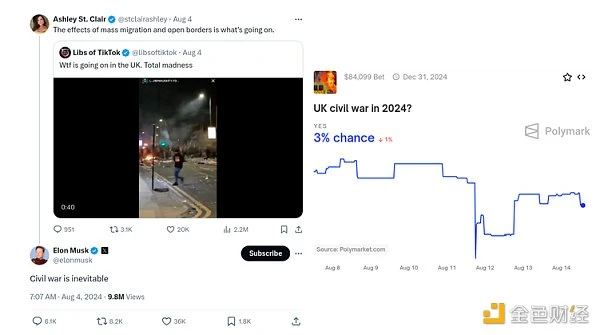
Left: Musk declares British civil war inevitable. Right: Polymarket gamblers, who are actually in on the action, put the odds of civil war at... 3% (I think thats way too high, but Im betting on it, too)
A prediction market is a place where different people are allowed to express their opinions on what will happen in the future. The advantage of prediction markets comes from the idea that when people have a stake, they are more likely to give high-quality opinions, and over time the quality of the system will improve, and people with incorrect opinions will lose money, and people with correct opinions will make money.
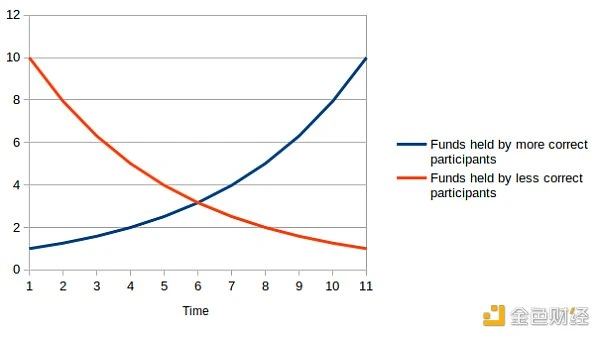
It’s important to note that while prediction markets are diverse in the sense that they are open to different participants, they are not in Glen and Audrey’s eyes. This is because they are a purely financial mechanism: they don’t distinguish between one person betting $1 million and a million unrelated people betting $1 million. One way to make prediction markets more diverse is to introduce per-person subsidies and prevent people from outsourcing the bets they make with those subsidies. There are some mathematical arguments that this does a better job than traditional prediction markets at stimulating the knowledge and insights of participants. Another option is to run a prediction market and also run a Polis-style discussion platform at the same time, encouraging people to submit reasons why they believe something - perhaps using soul-bound proofs of past market records to decide whose occurrences carry more weight.
Prediction markets are a tool that can be applied in many form factors and contexts. One example is retroactive public goods financing, where public goods are funded after they have had an impact and enough time has passed to evaluate the impact. RPGF is often considered in conjunction with an investment ecosystem, where upfront funding for public goods projects would be provided by venture capital funds and investors who predict which projects will be successful in the future. Both the ex-post part (evaluation) and the ex-ante part (prediction) can be made more diversified: some form of quadratic voting for the former and per capita subsidies for the latter.
The book and related articles on Pluralism dont really argue in terms of good vs. bad ideas and perspectives, just that there is more benefit to be gained from more diverse perspectives. On a resonance level, I think there is indeed a tension. However, if you believe that the measure of good vs. bad is important, then I dont think these foci are inherently incompatible: there are many ways to adopt ideas from one to improve mechanisms designed for the other.
Where can these ideas be applied first?
The most natural place for the idea of pluralism to apply is in the social context, where our society is already faced with the problem of how to improve cooperation among different and interacting tribes while avoiding centralization of power and protecting the autonomy of participants.
I personally am most optimistic about three experiments: social media, blockchain ecology and local government. Specific examples are as follows:
Twitter’s Community Notes, whose note ranking system is already designed to favor notes that gain broad support from participants, is a natural path to improving Community Notes is to find ways to combine it with prediction markets, thereby encouraging sophisticated participants to more quickly flag posts that will gain traction.
User-facing anti-fraud software. Message Checker, along with the Brave browser and some crypto wallets, are early examples of a paradigm for software that actively works on behalf of users to protect them from threats without the need for centralized backdoors. I expect software like this to be very important, but has an inherent decision-making problem of deciding what is and is not a threat. Pluralist theory can help solve this problem.
Public goods financing in the blockchain ecosystem. The Ethereum ecosystem makes extensive use of quadratic financing and traceability financing. Multiple mechanisms can help limit the collusion between these mechanisms and subsidize cooperation between parts of the ecosystem that face competing pressures (L2 expansion platforms and wallets).
Network nations, popup cities, and related concepts. New voluntary communities that form online based on shared interests and then “reify” offline need many things: (1) less authoritarian governance within, (2) more cooperation among themselves, and (3) more cooperation with the physical jurisdictions in which they reside. Pluralistic mechanisms can help improve all three.
Publicly funded news media. Historically, media have been funded either by audiences or by the executive branch of a centralized state. Pluralistic mechanisms allow for more democratic institutions that also explicitly strive to bridge the two poles and reduce rather than exacerbate polarization.
Local public goods. There are many hyperlocal governance and resource allocation decisions that could benefit from pluralistic mechanisms; my crypto-cities article contains some examples. One possible starting point is a quasi-city with a highly complex population, such as a university.
Today, I think the right way to think about pluralism is as an intuition pump for ideas about designing social mechanisms to better protect individual and community freedoms, enable large-scale cooperation, and minimize polarization. The above environments are a good basis for experimentation because they contain (i) real-world problems and resources, and (ii) people who are very interested in trying new ideas.
There are broader political questions about the structure of the 21st century world, including what level of sovereignty individuals, companies, and nations will have, how equal or unequal the world will ultimately become, and what kinds of powerful technologies will develop in what order and with what functional properties. There is much to be said about these topics, both in terms of the “pluralist atmosphere” and in terms of the specific meaning of pluralistic mechanism design theory.
There are often multiple, conflicting approaches to the same question. For example, pluralist theory implies that the promotion of a group or mechanism is valuable if it brings something unique and uncorrelated to the other dominant mechanisms in society. But are billionaires welcome imports of uncorrelated activity into a world dominated by nation-states whose internal decision-making logics are all extremely similar, or are more active nation-states welcome imports of diversity into a world dominated by homogeneous billionaire capitalism? Your answer will likely depend on your pre-existing feelings about the two groups.
For this reason, I think it’s best to think of pluralism not as a blanket replacement for your existing framework for thinking about the world, but rather as a supplement to it, basic ideas that can make all sorts of mechanisms better.










